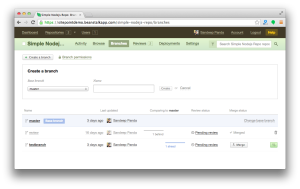
- #Move from beanstalk to bitbucket using sourcetree how to#
- #Move from beanstalk to bitbucket using sourcetree update#
- #Move from beanstalk to bitbucket using sourcetree software#
- #Move from beanstalk to bitbucket using sourcetree code#
- #Move from beanstalk to bitbucket using sourcetree free#
To verify that it is connected to the remote on BitBucket, click the "Settings" gear in the top right-hand corner and you should see the BitBucket remote in the "Remotes" section. Once that's done, you can double click the new bookmark and use SourceTree as you normally would. You can either clone it to a new location, or add the directory manually in the Local tab. Go into SourceTree, choose Clone repo, and point it to the newly created empty folder.
#Move from beanstalk to bitbucket using sourcetree code#
Since I already have this repo in another location, I'll move it to the trash.)Īdding an Existing Repo that Has a Corresponding Remote to SourceTreeįor some reason if you click "Clone" next to a repo you already have on your local machine and select the existing directory, it won't connect the remote repo with your existing copy. After creating the repo, go to your local file system, and temporarily rename you code bases root folder, then create a new empty folder. Select "Delete" (When you do that, you'll be asked whether you'd just like to remove the bookmark from SourceTree and leave the repo on your machine, or also move the repo to the Trash.Since I already have this repo on my machine in another location, I'll delete the copy that I just cloned. If it doesn't, double click on the bookmark in the list in the "Local" tab. To push contents from your local repository to a remote repository. To remove a file from staging, clear the checkbox next to the staged file. Click Commit at the bottom of the window.
#Move from beanstalk to bitbucket using sourcetree how to#
The repo will be cloned to your local machine and should open in a new window when it's done. This article should help users to understand how to change remote repository path via SourceTree, both in Git and Mercurial. Select the files to commit in the Pending files panel. Name: (This is the name of the bookmark that represents the repo in SourceTree).


Password: (Enter your BitBucket password).Username: (Enter your BitBucket username).
#Move from beanstalk to bitbucket using sourcetree update#
If you update your URL from HTTPS to SSH, next time you push or pull from your repository, the terminal responds that it is adding the Bitbucket host to the list of known hosts. Update the remote URL with git remote set-url using the current and new remote URLs.
#Move from beanstalk to bitbucket using sourcetree free#
Perhaps another video tut, “Git from the Ghitto” for us folks using free Git UI tools and Bitbucket would be greatly appreciated.Īlthough, I use the Terminal for simple tasks, I am too dumb for it. This takes the pain/fun from setting up an automated “hook.” Part of me wishes you weren’t using Beanstalk for automatic deployment.
#Move from beanstalk to bitbucket using sourcetree software#
Other Software Used GitHub, Bitbucket Read. Mark Jaquith on Working with WordPress Locally (specifically, dealing with plugins and config). Beanstalks main advantages lie in the support (which is excellent), deployment tools, and code review features. If you’ve got questions/comments/suggestions on this workflow, I’d love to hear! Then we make some local changes to our site, and commit/push them to Beanstalk, which does the deployment for us. Then we give Beanstalk our FTP credentials and set up how we want deployment done. Then we set up a Git repository in Beanstalk and push it all up to that. We start by moving the live website local, including bringing all the files down and copying the database. I haven’t had much experience with this, so forgive me if it’s a bit rough.


In this screencast I move my own personal website from my old live FTP editing ways to a proper version controlled system including deployment.


 0 kommentar(er)
0 kommentar(er)
